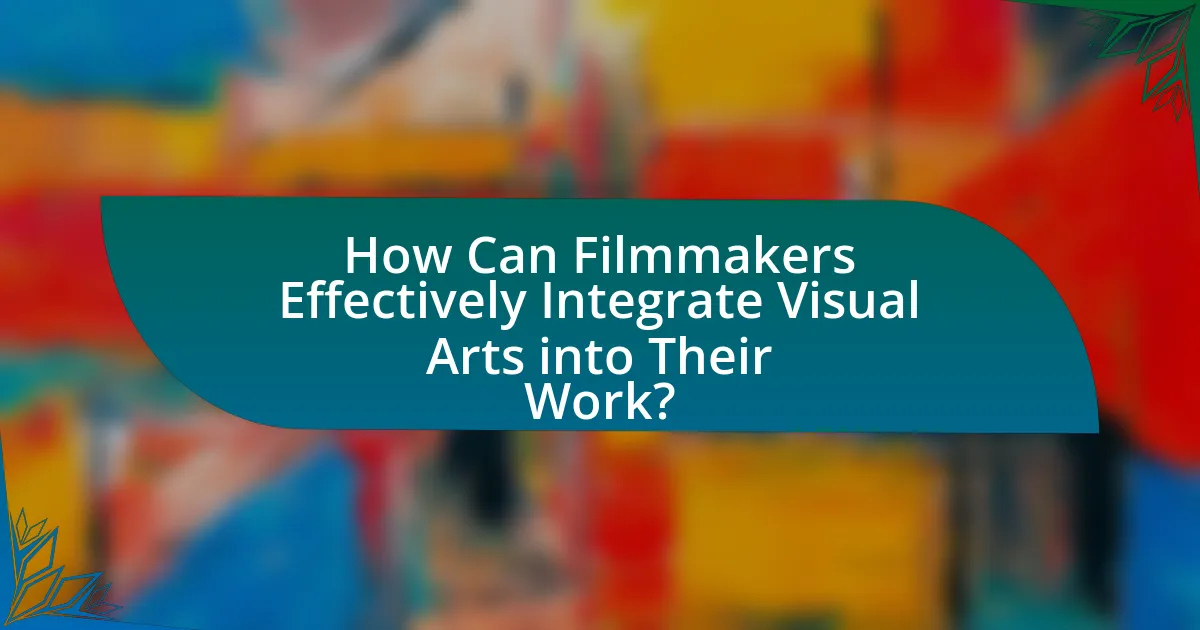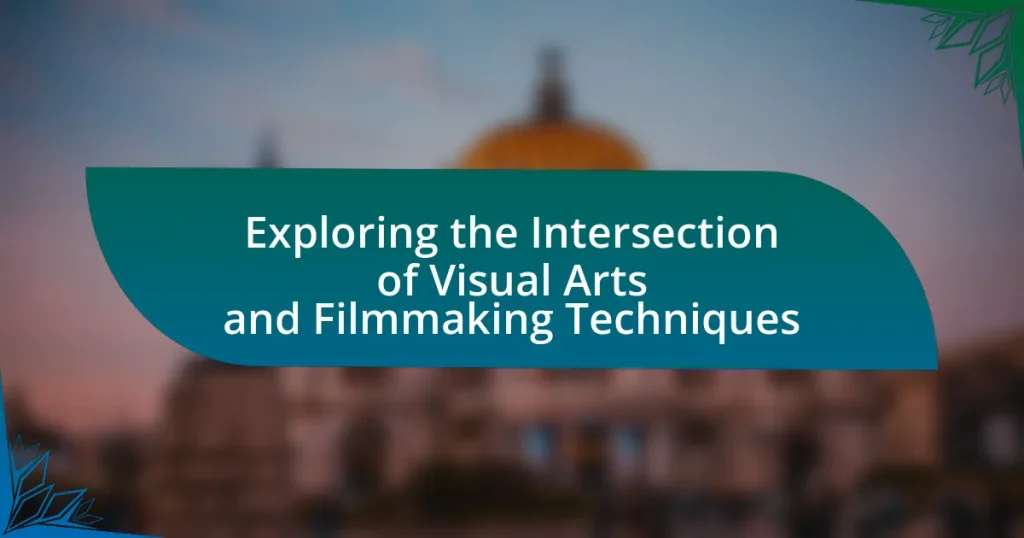The article explores the intersection of visual arts and filmmaking techniques, highlighting their shared focus on visual storytelling and composition. It examines how visual arts influence filmmaking through principles such as color theory, composition, and lighting, enhancing emotional engagement and narrative depth. Key techniques from visual arts, including painting, sculpture, and photography, are integrated into filmmaking to create compelling visuals and themes. The article also discusses the importance of collaboration between filmmakers and visual artists, the challenges faced in merging these disciplines, and practical strategies for maintaining a cohesive vision throughout the project.

What is the Intersection of Visual Arts and Filmmaking Techniques?
The intersection of visual arts and filmmaking techniques lies in their shared emphasis on visual storytelling and composition. Both disciplines utilize elements such as color, form, and texture to convey emotions and narratives. For instance, filmmakers often draw inspiration from painting and sculpture to create visually compelling scenes, employing techniques like framing and lighting that are rooted in visual art principles. Historical examples include the influence of Impressionism on cinematography, where the use of light and color in films mirrors the techniques of artists like Claude Monet. This synergy enhances the viewer’s experience by merging artistic expression with cinematic storytelling.
How do visual arts influence filmmaking techniques?
Visual arts significantly influence filmmaking techniques by providing foundational aesthetics, composition, and color theory that filmmakers utilize to enhance storytelling. For instance, the principles of visual arts, such as balance, contrast, and harmony, are applied in cinematography to create visually compelling scenes that evoke specific emotions. Historical examples include the use of chiaroscuro lighting in film noir, which draws from painting techniques to create mood and tension. Additionally, filmmakers often reference visual art movements, such as Impressionism or Surrealism, to inform their visual style and narrative approach, as seen in works by directors like Federico Fellini and Jean-Luc Godard. This integration of visual arts into filmmaking not only enriches the visual experience but also deepens the audience’s emotional engagement with the narrative.
What specific visual art forms are commonly integrated into filmmaking?
Filmmaking commonly integrates specific visual art forms such as painting, sculpture, photography, and graphic design. These art forms contribute to the visual storytelling in films by enhancing aesthetics, creating mood, and establishing themes. For instance, the use of painting in set design can evoke particular emotions, while photography influences the cinematography style, as seen in films that mimic the composition of famous artworks. Additionally, graphic design plays a crucial role in creating visual identities for films through posters and title sequences, further solidifying the connection between visual arts and filmmaking.
How does the use of color theory in visual arts enhance cinematic storytelling?
The use of color theory in visual arts enhances cinematic storytelling by influencing audience emotions and perceptions. Color can evoke specific feelings; for instance, warm colors like red and orange can create a sense of urgency or passion, while cool colors like blue and green can evoke calmness or sadness. This emotional manipulation is supported by research from the field of psychology, which indicates that colors can significantly affect mood and behavior. For example, in films like “The Grand Budapest Hotel,” director Wes Anderson employs a distinct color palette to convey themes of nostalgia and whimsy, effectively guiding the audience’s emotional journey. Thus, color theory serves as a powerful tool in visual storytelling, shaping the narrative and deepening viewer engagement.
Why is understanding this intersection important for filmmakers?
Understanding the intersection of visual arts and filmmaking techniques is crucial for filmmakers because it enhances their ability to create compelling narratives through visual storytelling. This intersection allows filmmakers to utilize principles of composition, color theory, and visual aesthetics, which are foundational in visual arts, to evoke emotions and convey themes effectively in their films. For instance, renowned filmmaker Wes Anderson employs meticulous color palettes and symmetrical compositions, drawing directly from visual art influences, to establish a unique narrative style that resonates with audiences. By integrating these artistic elements, filmmakers can elevate their work, making it more engaging and visually striking, ultimately leading to a more profound viewer experience.
What skills can filmmakers gain from studying visual arts?
Filmmakers can gain a variety of skills from studying visual arts, including enhanced visual storytelling, composition, color theory, and an understanding of aesthetics. These skills are crucial for creating compelling narratives and engaging visuals in film. For instance, knowledge of composition allows filmmakers to frame shots effectively, while color theory helps in setting the mood and tone of a scene. Studies have shown that filmmakers who integrate visual arts principles into their work often produce films that resonate more deeply with audiences, as they utilize visual elements to evoke emotions and convey themes.
How does this knowledge impact audience engagement and perception?
Knowledge of the intersection between visual arts and filmmaking techniques significantly enhances audience engagement and perception by creating a more immersive and emotionally resonant experience. This understanding allows filmmakers to utilize visual storytelling elements, such as composition, color theory, and symbolism, which can evoke specific emotions and reactions from viewers. For instance, studies have shown that films employing strong visual aesthetics can increase audience retention and emotional involvement, as evidenced by research from the University of Southern California, which found that visually compelling narratives lead to higher viewer satisfaction and connection to the story. Thus, leveraging this knowledge effectively can transform how audiences perceive and engage with cinematic content.

What are the Key Techniques in Visual Arts Applied to Filmmaking?
Key techniques in visual arts applied to filmmaking include composition, color theory, lighting, and visual storytelling. Composition involves the arrangement of elements within the frame to guide the viewer’s eye and create balance, as seen in the rule of thirds. Color theory influences mood and emotion; for example, warm colors can evoke feelings of warmth and comfort, while cool colors may suggest calmness or sadness. Lighting techniques, such as chiaroscuro, enhance depth and dimension, creating dramatic effects that influence the narrative. Visual storytelling integrates these elements to convey themes and character development, as demonstrated in films like “The Grand Budapest Hotel,” where meticulous visual design supports the narrative.
How do composition and framing in visual arts translate to film?
Composition and framing in visual arts translate to film by establishing visual storytelling techniques that guide audience perception and emotional response. In both mediums, the arrangement of elements within the frame influences how viewers interpret the narrative; for example, the rule of thirds, commonly used in painting, is also applied in cinematography to create balanced and engaging shots. Additionally, visual arts utilize color, light, and perspective to evoke feelings, which filmmakers replicate through lighting design, color grading, and camera angles to enhance mood and thematic depth. This connection is evident in the works of filmmakers like Wes Anderson, who employs symmetrical compositions reminiscent of classical paintings, demonstrating how visual art principles can effectively shape cinematic language.
What are the principles of composition that filmmakers should consider?
Filmmakers should consider several key principles of composition, including balance, contrast, emphasis, movement, pattern, rhythm, and unity. Balance involves distributing visual weight evenly across the frame to create stability, while contrast highlights differences in elements to draw attention. Emphasis directs the viewer’s focus to a specific subject, often achieved through placement or lighting. Movement guides the viewer’s eye through the composition, and pattern creates visual interest through repetition. Rhythm establishes a sense of flow, and unity ensures that all elements work together cohesively. These principles are foundational in creating visually compelling narratives that engage audiences effectively.
How does framing affect the narrative and emotional impact of a scene?
Framing significantly influences both the narrative and emotional impact of a scene by determining how viewers perceive and interpret visual information. The choice of framing can highlight specific elements, guide audience focus, and evoke particular emotional responses. For instance, a close-up shot can create intimacy and urgency, drawing viewers into a character’s emotional state, while a wide shot can establish context and distance, affecting the viewer’s connection to the scene. Research by Bordwell and Thompson in “Film Art: An Introduction” illustrates that framing shapes narrative comprehension by controlling the visual information presented, thereby influencing how audiences engage with the story and its emotional undertones.
What role does lighting play in both visual arts and filmmaking?
Lighting serves as a fundamental element in both visual arts and filmmaking, shaping the perception of the subject and influencing the emotional tone of the work. In visual arts, lighting can create depth, highlight textures, and guide the viewer’s focus, as seen in the chiaroscuro technique used by artists like Caravaggio, which employs strong contrasts between light and dark to enhance drama. In filmmaking, lighting is crucial for establishing mood, character, and setting; for instance, high-key lighting creates a bright, cheerful atmosphere, while low-key lighting can evoke suspense or tension, as demonstrated in film noir classics. The strategic use of lighting in both disciplines not only enhances aesthetic appeal but also communicates narrative and emotional undertones effectively.
How can filmmakers utilize lighting techniques from visual arts?
Filmmakers can utilize lighting techniques from visual arts by adopting methods such as chiaroscuro, color theory, and the use of shadows to enhance mood and narrative. Chiaroscuro, which involves the strong contrast between light and dark, can create dramatic tension and depth in a scene, similar to how it is used in painting. Color theory allows filmmakers to evoke specific emotions through color palettes, as seen in works by artists like Van Gogh, who used color to convey feelings. Additionally, the strategic placement of shadows can add layers of meaning and visual interest, mirroring techniques used by artists like Rembrandt. These techniques have been proven effective in films such as “The Godfather,” where lighting plays a crucial role in storytelling and character development.
What are the effects of different lighting styles on mood and tone in film?
Different lighting styles in film significantly affect mood and tone by influencing how viewers perceive scenes and characters. For instance, high-key lighting, characterized by bright illumination and minimal shadows, often creates a cheerful and optimistic atmosphere, commonly used in comedies and musicals. Conversely, low-key lighting, which features strong contrasts and deep shadows, tends to evoke feelings of suspense or drama, frequently utilized in thrillers and horror films.
Research indicates that lighting can alter emotional responses; a study published in the Journal of Experimental Psychology found that participants rated scenes with warm lighting as more inviting and friendly compared to those with cold lighting, which were perceived as harsh and unwelcoming. Additionally, colored lighting can also impact mood; for example, blue lighting is often associated with sadness or calmness, while red lighting can evoke feelings of anger or passion. Thus, filmmakers strategically use various lighting techniques to shape audience emotions and enhance storytelling.

How Can Filmmakers Effectively Integrate Visual Arts into Their Work?
Filmmakers can effectively integrate visual arts into their work by collaborating with visual artists to enhance storytelling through visual aesthetics. This collaboration can involve incorporating techniques from painting, sculpture, and graphic design to create a cohesive visual narrative that complements the film’s themes. For instance, the use of color palettes inspired by famous artworks can evoke specific emotions, as seen in films like “The Grand Budapest Hotel,” where Wes Anderson utilized a distinct color scheme reminiscent of visual art styles. Additionally, filmmakers can employ visual art principles such as composition and perspective to guide audience focus and enhance visual storytelling. This approach not only enriches the film’s visual language but also creates a deeper connection between the audience and the narrative.
What are some best practices for incorporating visual art techniques in film?
Incorporating visual art techniques in film can be effectively achieved through several best practices. First, filmmakers should study and integrate color theory to evoke specific emotions and set the tone of scenes, as demonstrated by directors like Wes Anderson, who uses a distinct color palette to create a unique visual style. Second, employing composition techniques from visual art, such as the rule of thirds and leading lines, can enhance storytelling by guiding the viewer’s eye and emphasizing key elements within the frame. Third, utilizing texture and layering can add depth to scenes, as seen in the works of filmmakers like Guillermo del Toro, who often incorporates intricate details to create immersive worlds. Lastly, collaboration with visual artists can bring fresh perspectives and innovative ideas, as evidenced by the partnerships between filmmakers and contemporary artists in projects like “The Shape of Water,” which blended various artistic influences. These practices not only enrich the visual narrative but also create a more engaging cinematic experience.
How can collaboration with visual artists enhance a film project?
Collaboration with visual artists can enhance a film project by integrating unique aesthetic perspectives and innovative visual storytelling techniques. Visual artists contribute specialized skills in areas such as set design, costume creation, and visual effects, which can elevate the overall visual quality and emotional impact of the film. For instance, films like “Pan’s Labyrinth,” directed by Guillermo del Toro, showcase how collaboration with visual artists can create immersive worlds that resonate with audiences, blending narrative and visual artistry seamlessly. This partnership not only enriches the film’s visual language but also fosters creative synergy, leading to more compelling and original cinematic experiences.
What tools and resources are available for filmmakers to learn about visual arts?
Filmmakers can utilize various tools and resources to learn about visual arts, including online courses, books, and software. Online platforms like MasterClass and Coursera offer courses taught by industry professionals, covering topics such as composition, color theory, and visual storytelling. Books such as “The Visual Story” by Bruce Block provide foundational knowledge on visual structure and design principles. Additionally, software like Adobe Creative Suite enables filmmakers to practice and apply visual arts techniques in their projects. These resources collectively enhance filmmakers’ understanding of visual arts, which is crucial for effective storytelling and audience engagement.
What common challenges do filmmakers face when merging these disciplines?
Filmmakers commonly face challenges such as balancing artistic vision with technical constraints when merging visual arts and filmmaking techniques. This includes difficulties in integrating diverse visual styles, which can lead to inconsistencies in the final product. Additionally, filmmakers often struggle with collaboration among artists from different disciplines, as varying perspectives and methodologies can create conflicts. Budget limitations further complicate the process, restricting the ability to fully realize creative ideas. Historical examples, such as the challenges faced in the production of “Avatar,” illustrate how merging advanced visual effects with traditional filmmaking requires careful coordination and resource management to achieve a cohesive outcome.
How can filmmakers overcome creative differences with visual artists?
Filmmakers can overcome creative differences with visual artists by fostering open communication and collaboration throughout the project. Establishing a shared vision at the outset allows both parties to align their creative goals, which can be reinforced through regular meetings and feedback sessions. Research indicates that projects with collaborative frameworks often yield higher satisfaction and better outcomes, as seen in the success of films like “Avatar,” where extensive collaboration between filmmakers and visual artists led to groundbreaking visual effects. This approach not only mitigates conflicts but also enhances the creative process, resulting in a more cohesive final product.
What strategies can be employed to maintain a cohesive vision in a project?
To maintain a cohesive vision in a project, clear communication among team members is essential. Establishing a shared understanding of the project’s goals, objectives, and aesthetic direction ensures that all contributors are aligned. Regular meetings and updates facilitate this communication, allowing for feedback and adjustments as needed. Additionally, creating a comprehensive project brief that outlines the vision, style, and key elements serves as a reference point for all team members. This approach is supported by studies indicating that teams with defined goals and open communication channels are more likely to achieve project coherence and success.
What practical tips can filmmakers use to explore this intersection?
Filmmakers can explore the intersection of visual arts and filmmaking techniques by integrating visual art principles into their storytelling. This can be achieved by studying color theory to enhance emotional impact, utilizing composition techniques from painting to frame shots effectively, and experimenting with different visual styles inspired by various art movements. For instance, filmmakers can analyze the works of artists like Vincent van Gogh to understand the use of color and brush strokes, which can inform their cinematography choices. Additionally, collaborating with visual artists can provide fresh perspectives and innovative ideas, enriching the film’s aesthetic and narrative depth.


